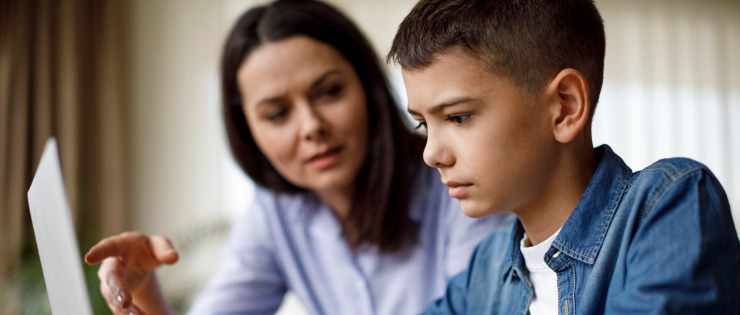
Online bullying is a fear of many parents. The bullying threat is no longer confined to the schoolyard, it follows children wherever they go. Many parents worry that they know little about cyberbullying because it wasn’t a threat when they were kids. Other parents understand it but don’t know what they can do to keep their children safe. Read on for some tips on what you can do.
What is Cyberbullying?
Cyberbullying is bullying on electronic devices such as computers, mobile phones, iPad or tablets. Cyberbullying can occur through text messages, apps, social media, websites, forums or online gaming where content can be publicly viewed and shared. Cyberbullying is a growing problem in society, 64% of teens who have reported being cyberbullied stated it affects their ability to learn and feel safe at school.
There are many cyberbullying tactics but some of the most common include:
- Sending abusive messages via text, email or social media
- Posting hurtful content about a victim’s race, religion, or characteristics online
- Posting a video or photo online designed to embarrass someone publicly
- Threatening someone online with physical harm or telling them to kill themselves
- Excluding people online
- Using false information to pretend to be someone else and posting about another person
- Hacking into someone's social media account to steal information and or, send damaging messages
- Threatening or destroying privacy by making information public
- Setting up a website to demean a person
- Sharing or forwarding sexually suggestive or explicit pictures or messages

How is Online Bullying Different to Traditional Bullying?
Both cyberbullying and traditional bullying are just as devastating for the victim. Every act of bullying is designed to inflict pain and harm on someone else. Traditional bullying is when a person or group of people have power over another person and repeatedly use words or actions to hurt them. The different types of bullying include:
Verbal – Threatening to cause someone harm, name calling, putting down and teasing
Physical – Kicking, punching, hitting, tripping, breaking someone’s belongings, and rude hand signs
Social - Spreading rumours, lies, deliberating excluding or embarrassing someone in front of others.
These types of bullying don’t use technology whereas cyberbullying is using a mobile phone, computer, iPad or tablet to send, share or post harmful content.
The main differences between traditional bullying and cyberbullying are:
- Cyberbullying can occur 24-hours a day, 7-days a week. A cyberbully can reach your child even when they are safe at home.
- Messages can be sent anonymously and shared very quickly. It can also be difficult to track down the source of where the message, image or video came from.
- Deleting/ removing images, videos, messages and texts online can sometimes be impossible once they have been shared.
How Prevalent is Cyberbullying?
Cyberbullying is more common than you think. The statistics around cyberbullying are worrying. A recent study conducted by the Cyberbullying Research Centre found that out of 4,972 middle and high school students surveyed in the US - 37% of them have experienced cyberbullying throughout their lifetime. According to the i-SAFE Foundation, over half of all adolescents and teenagers have been bullied and around 25% of young people have been cyberbullied repeatedly. Often parents never hear about it because only 1 in 10 kids report that they have been cyberbullied.

Children who are victims of bullying and cyberbullying may:
- Skip school or refuse to go
- Suffer poor grades
- Have poor self esteem
- Struggle to sleep
- Feel hopeless and powerless
- Have thoughts about harming yourself
- Use alcohol or drugs
- Suffer anxiety or depression
- Be at risk of suicide
How Can You Prevent Cyberbullying?
It’s nearly impossible to prevent cyberbullying but you can reduce the chance of it happening to your child. Most of the time, a victim can’t even prevent the bullying from starting, but as a parent you can put some measures in place to help keep your child safe.
Establish Rules Around Technology Use
Kids should have rules they have to follow if they want to use a mobile phone, laptop, computer, iPad or tablet. You should explain to them you have rules to help keep them safe from cyberbullying and other risks they are exposed to in the online world. Being involved in your child’s technology use can be beneficial, not only are you vetting the content they are accessing but you are also bonding through a shared experience. None of the following suggestions are foolproof for a variety of reasons (one of them being what works for one child might not work for another), but it lets your kids know you’re monitoring them.
- Talk to your child regularly about the sites they are visiting and online activities they do and who they are talking to online
- Know what they text and their behaviours online
- Remind them not to accept everyone that sends a friend request. Only accept requests from people you know in real life
- “Follow” or request to be “friends” with your child on social media sites
- Remind your child to tell you if they have experienced cyberbullying or someone they know has
- Explain to your child that they should never post or share anything that could embarrass or hurt anyone
- Remind your child to keep their passwords safe and never share it with friends
- Only allow access to the computer or laptop in a shared area of the house like the family room rather than in their room
- Make sure your child understands the school’s policy on technology and the laws around sexting and cyberbullying

Using Parental Control
Along with setting up rules, some parents like the backing of an online parental control system. It allows parents to:
- Limit social media, online gaming and screen time
- Block inappropriate content
- Track smart devices
- Manage in-app purchases
- Set bedtimes and study periods
Online Gaming
Most teenagers engage in some form of online gaming. They may play web, console or computer-based games with friends and sometimes strangers from all around the world. Any form of online gaming increases the risk of your child being cyberbullied.
Using avatars and fictional user names mean players can use the anonymity to bully, harass and gang up on other players. They can send, post or say hurtful and negative messages. Some players interact on a game so they can gain another player’s username, password and personal information.
You should monitor your children playing online games by:
- Watching when they’re online or checking in to ask who they are playing with
- Set parameters around which games they can play and how much time they can play
Explain to your child what they shouldn’t do when they’re playing online such as:
- Clicking on any links a stranger has sent them
- Never share their personal information to strangers
- Never take part in bullying or hurtful comments
- What to do if they see someone else being bullied
Social Media
Common Sense Media released a report in 2018 stating that 7 in 10 US teens check their social media accounts more than once a day. The difficulty for parents is keeping up with all the different sites your child might be using. Many parents would struggle to name more than a few social media platforms.

Some social media sites commonly used by children include:
- Askfm
- Chatroulette
- Discord
- Facebook
- Instagram
- Kik
- Line
- Reddit
- Snapchat
- Telegram
- Tumblr
- Twitter
- Vine
- WeChat
- WhatsApp
- YouTube
Risk of Social Media Sites
Children face a wide range of risks on social media sites including:
- Viewing adult content
- Personal information including age, location and phone number can be obtained
- Once something is posted online it can be difficult to remove
- Privacy controls can be limited or they’re not aware of how they work
- Exposed to online predators
- Identity fraud
- Trolling
- Catfishing
Warning Signs to Look Out For

Some children will try to hide incidents of cyberbullying from their parents, but a vigilant parent can identify a warning sign that their child is being bullied.
Signs to look out for cyberbullying include:
- Deleting social media accounts
- Setting up new social media accounts
- Increased or decreased use of their device
- Wanting to hide their screen when other people are around
- Being withdrawn or depressed, loss of interest in activities they once enjoyed
- Avoiding social situations
What to Do if your Child is Involved in Cyberbullying
It’s normal to feel out of your depth when your child is suffering from cyberbullying. After all, you didn’t experience it when you were a child.
Talk to your Child
Open communication between a parent and children is important for cyber safety.
About Being Cyberbullied
Unfortunately, not all children want to talk about being bullied. They may feel embarrassed, ashamed for no reason or find it too painful to discuss. If your child doesn’t want to talk, don’t force them. Reassure them it’s not their fault and the bully shouldn’t get away with it. Ask questions about when it started and who is involved. Ask to see their device or if they have taken any screenshots. However, cyberbullying can be hidden on apps and sites that don’t appear in the call or text message logs of mobile phones.
About Being a Cyberbully
Most incidents of cyberbullying are malicious but not always. What some kids think is funny, can be hurtful to another. Explain the importance of thinking before they text, say or post anything. Ask themselves if their comment may hurt another person. If they wouldn’t want it said about them or seen by anyone then don’t say it at all. Remind them that messages can be forwarded, screenshot and can resurface in years to come. Hiding behind a fake name or account won’t protect their bad behaviour, they can still be found out. Tell them that any bad behaviour today can follow them.
Document and Report the Incidents of Cyberbullying
Take a screenshot or photo of posts that contain bullying and make a note of where and when they occurred. Notify the school if the bully attends the same school as your child. If offensive content appears on an app or social media site, ask to have it removed and report it on the app. If there is any physical threat, child pornography, explicit messages or photos, illegal behaviour or potential crime, and/or stalking contact the police immediately.
What Not to Do if your Child is Cyberbullied
Parents should know some actions they take in attempt to fix the problem can make the situation much worse.

Taking Away Their Devices
When a child is being cyberbullied, a parent’s first reaction is to remove the threat by taking away their child’s phone and computer. However, this is for most children their biggest fear and the reason most kids don’t tell their parents about cyberbullying incidents. You’re punishing your child for another person’s bad behaviour. The best option is to block and unfriend people who are threatening your child. Change your child's privacy settings online and keep an eye on the situation.
Hope it will Resolve Itself
Cyberbullying is different to schoolyard and highschool drama. Children and teens are inevitably going to run into some problems, so you need to be able to handle both. Cyberbullying can escalate quickly and have a long-lasting and devastating impact on children and young adults.
All types of online bullying can have a detrimental impact. If your child is anxious or depressed after being bullied, they may need to talk to a counsellor or psychologist.
Always Report Cyberbullying
Bullies shouldn’t get away with cyberbullying. It’s important that victims (or their parents) report it. Social media platforms and internet service providers have terms and conditions or rights and responsibilities which describe what content is acceptable and what’s not. By reporting cyberbullying to a social media platform, they can remove the content and take action against users who abuse the terms of use.
Helpful Resources For Parents
These are links to websites that can help you have some control over your children’s technology use.
Life360 – Location tracking tool
Xbox Controls - Implement the in-built parental controls on Xbox consoles
Playstation Controls- Implement the in-built parental controls on Playstation consoles
Game Quitters – For people with excessive gaming behaviour
Apple Restrictions – Instructions on how to implement restrictions on Apple devices